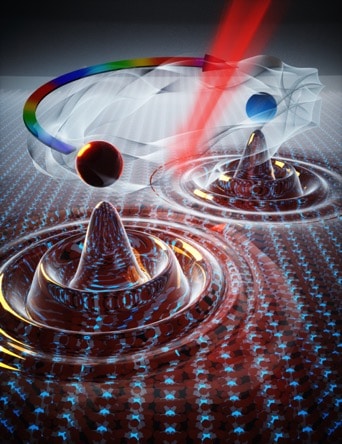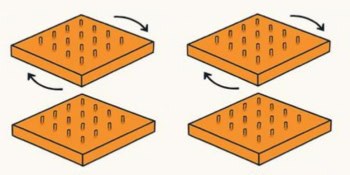
Researchers in the US have induced a huge and nearly dissipationless current in zirconium pentatelluride – a technologically important material that exhibits strong topological electronic effects – by illuminating it with laser light. The mechanism responsible for the effect, which occurs as the material’s crystal lattice “twists”, might find use in quantum computing applications and high-speed, low-power electronic devices.
Topological insulators are electrically insulating in their bulk, but they can conduct electricity extremely well on their surfaces (or edges) via special electronic states that are protected from fluctuations in their environment. Within these states, electrons can only travel in one direction (or channel) and do not backscatter. Since backscattering is the main dissipating process in electronics, topological insulators can carry electrical current with near-zero dissipation. This means they could be used to make electronic devices that are far more energy-efficient than any that exist today. The dissipationless electric currents in topological materials could also become the basis for quantum bits (qubits) because the materials shield fragile quantum states from impurities and lattice vibrations.
For physicists, zirconium pentatelluride (ZrTe5) is a particularly interesting topological material because it exists in a wide variety of topological phases. Indeed, depending on how it is configured, it can behave as a weak or strong topological insulator, a 3D quantum Hall state or a Dirac semimetal. In the latter phase, ZrTe5 exhibits exotic electron conduction behaviour thanks to the unique state of its crystal lattice and electronic structure, which protect electrons from backscattering, explains Jigang Wang, a physicist at the US Department of Energy’s Ames Laboratory and Iowa State University. “The anomalous electron transport channels protected by the symmetry and topology in ZrTe5 don’t normally occur in conventional metals such as copper,” he says.
Light-induced giant current
Wang and colleagues at Brookhaven National Laboratory and the University of Alabama at Birmingham discovered that they could generate a huge current in ZrTe5 by exposing the material to laser light at terahertz frequencies. This current arises because light at these frequencies triggers vibrations, or phonons, in the material’s crystal lattice that distort its symmetry.
The researchers explain that this effect, which they term phononic symmetry switching, gives rise to points in the twisted lattice where electrons behave like Weyl fermions – massless particles capable of carrying the sought-after, protected, low-dissipation current.
Weyl fermions were first predicted in 1929 by the theoretical physicist Herman Weyl, who identified them as possible solutions of the Dirac equation. Electrons of the Weyl type behave very differently to electrons in ordinary metals or semiconductors. Indeed, Wang and colleagues found that the electrons in their twisted ZrTe5 travel at very high velocities – near a fraction of light speeds (~c/300) – over distances as long as 10 microns.
Universal topology control principle?
The researchers, who report their work in Nature Materials, note that phononic symmetry switching enables them to control the flow of electrons without using electric or magnetic fields. Such a fast, low-energy, symmetry-based switch was lacking until now, says team member Qiang Li, who heads the Advanced Energy Materials Group at Brookhaven. “Our results add to a broader picture of quantum control of topological systems with symmetry selective infrared and Raman coherent phonon pumping suitable for these applications,” Li tells Physics World.

Time reversal symmetry breaks in ferromagnetic Weyl semimetals
The team says it now plans to extend its method to explore other topologically-based ways of controlling electron flow in materials relevant for topological effect transistors, quantum computing and spintronics. “This light-induced Weyl semimetal transport and topology control principle appears to be universal and will be very useful in the development of future quantum computing and electronics with high speed and low energy consumption,” says team member Ilias Perakis of Alabama-Birmingham.



